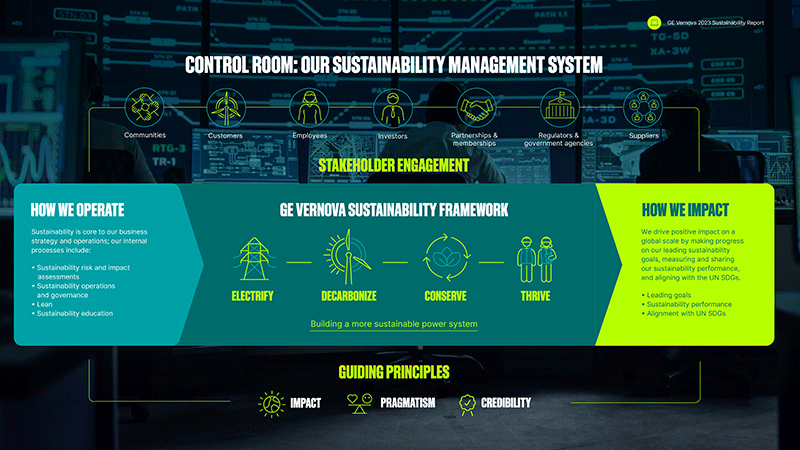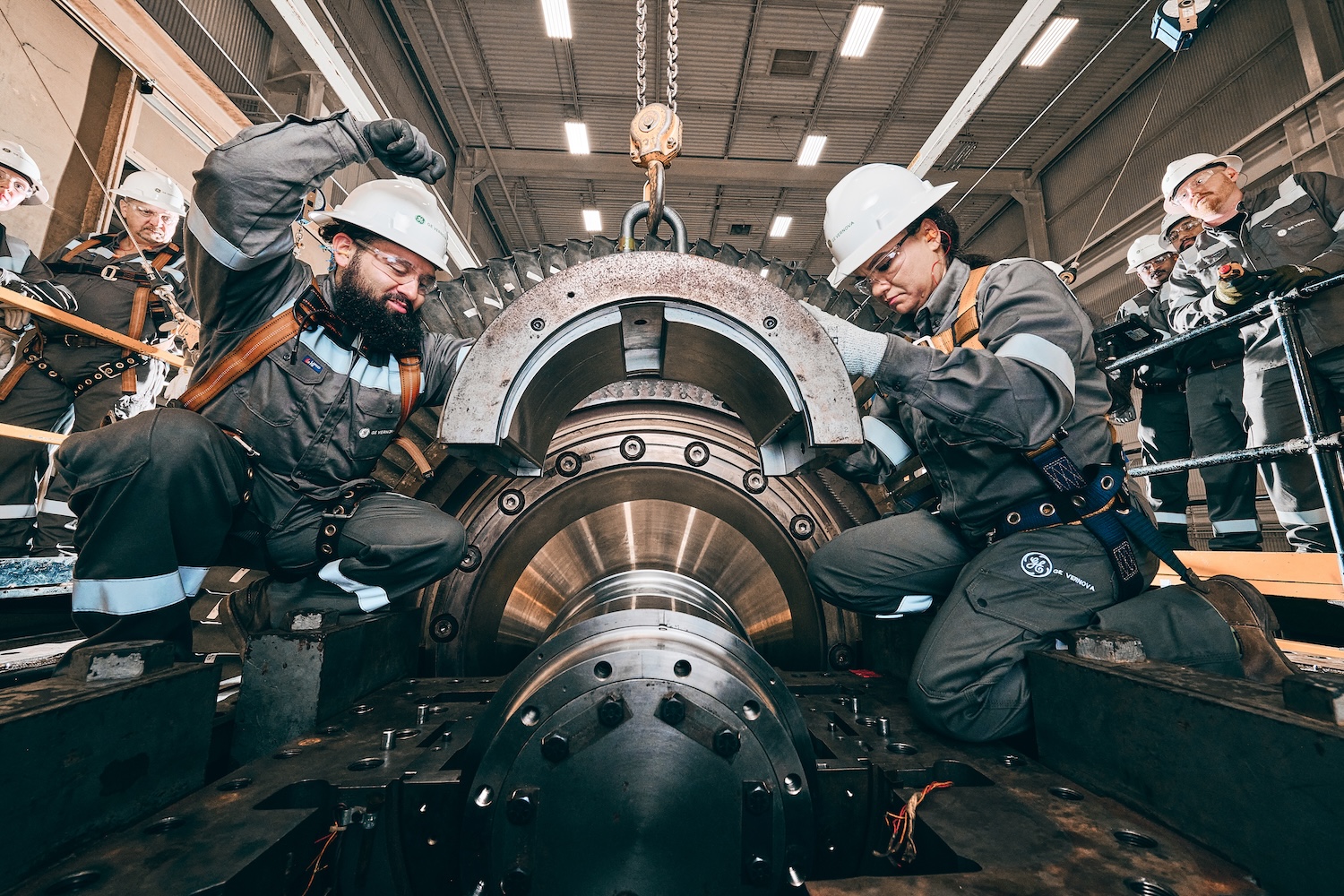GE Vernova now has nearly six months under its belt as a standalone purpose-built energy technology company. Nimbler and with a new stock listing and management team, the Cambridge, Massachusetts–based company is only getting started, unfurling its sails and setting a course all its own.
But this new identity brings with it new responsibilities. Approximately 25% of the world’s electricity is generated with the help of GE Vernova’s technology base. Accordingly, as more and more of the world transitions toward electricity playing a bigger role in industrial systems, GE Vernova believes it has an important role to play to help meet the planet’s growing energy demands while steering that growth toward a decarbonized power system. To align the company’s business objectives and these broader goals, GE Vernova has laid out a road map of leading sustainability targets and strategies that it can follow and measure itself against. To set the course, GE Vernova today unveils its new Sustainability Report and website, diving deeper into these goals, metrics, investments, technologies, and progress.
The ambitious report draws upon GE Vernova’s heritage at the nexus of the global energy transition, and strikes a bond with accountability. “If we think about sustainability reports 10, 20 years ago, how they started, some came about almost as a publicity exercise. Things are very different today, and accountability is front and center,” says Santiago Castanedo, sustainability communications leader.
Balancing the Energy Transition’s Growth with Building Sustainable Energy Infrastructure
GE Vernova’s debut Sustainability Report comes as the global energy transition is set to bring increasingly strong growth to power grids. And while growth itself produces the helpful momentum that transition needs to thrive, a rapidly expanding grid can make for challenging conditions as the world tries to swap out existing generation while also building anew. Indeed, the International Energy Agency (IEA) just increased its forecast of global power growth to 4% this year, and another 4% next year. That’s a significant increase from previous years, and we may even see higher growth rates as the transition builds momentum. For the transition to succeed, the world not only needs to cover that growth with existing types of energy like renewables, gas, and nuclear, but needs to deploy breakthrough innovations, like hydrogen-ready gas turbines, carbon capture solutions, and small modular reactors, that appear increasingly capable of lowering carbon emissions once supporting infrastructure is deployed at scale. With global power demand expected to grow by more than 50% in the next 20 years, the race to decarbonize has officially begun.

Developing GE Vernova’s 2023 Sustainability Report required the expertise of the company’s round-the-world workforce, with professionals in every corner weighing in, from the advanced research team to each of the company’s segments in power, wind, and electrification. The companywide effort began last year, well before the GE Vernova spinoff. According to Jordan Deasy, sustainability reporting and communications manager, over 70 contributors and more than 90 reviewers across the company’s corporate functions and businesses, as well as multiple external advisers, were involved in the effort.
A Modern Sustainability Company Begins With a Modern Sustainability Management System
The result of this effort is a new sustainability management system that the team calls “the Control Room,” inspired by the concept of control rooms in the power sector, “a place of unflappable professional execution in operating what’s been described as the planet’s most complex machine, the electric grid,” says Roger Martella, GE Vernova’s chief sustainability officer and head of government affairs. “The execution of our Control Room and the sharing of our inaugural Sustainability Report are the culmination of work that began over a year before GE Vernova’s legal creation.”
At the outset, more than 30 employees from all functions, businesses, and regions came together in Brussels, Belgium, with scores of ideas, but Martella recalls that all of them agreed on one thing: “Before we could succeed in our goals, we had to first create the system.” The GE Vernova Control Room calls for continuous improvement and engagement with the company’s external and internal stakeholders to evolve and foster real, measurable progress on solving the world’s sustainability challenges.

GE Vernova’s Four Pillars: Electrification, Decarbonization, Conserve, and Thrive
“There’s a lot of credibility and reputation that comes with being an energy company and delivering on climate objectives,” says Cheryl Fladung, senior sustainability compliance and disclosures manager at GE Vernova. This is why the company’s Sustainability Framework is at the core of the Control Room, translating the company’s sustainability focus to its four pillars — electrify, decarbonize, conserve, and thrive — driving accountability toward its leading goals and metrics. “If we’re not willing to disclose our goals and have transparency about our progress to achieve our climate goals, stakeholders may see that as a significant miss,” says Fladung. She and the team feel that the practice of ongoing emissions disclosures drives both accountability and the fullest engagement with the company’s stakeholders.
Electrify recognizes that job one of the energy transition is to meet the growing demand for power around the world, in line with the United Nations’ Sustainable Development Goal 7, to “ensure access to affordable, reliable, sustainable and modern energy for all” by 2030. According to the IEA, more than 760 million people still lack access to power, and GE Vernova’s Sustainability Framework specifically focuses on emerging economies and underserved populations. Decarbonize advances GE Vernova’s mission to innovate technology this decade and aim to develop breakthrough technologies for the future that seek to solve the problem of reducing emissions while electrifying the world. Here GE Vernova includes metrics focused both on near-term progress this decade and long-term efforts for its 2050 net zero ambition. Conserve focuses on GE Vernova’s own footprint, and applying lean approaches to manufacturing, shipping, and rejuvenating its energy technology to facilitate reductions in the company’s own emissions and material footprint. Thrive recognizes that through its operations and value chain, GE Vernova prioritizes people first, from safety and inclusion to ethics, compliance, and human rights. These goals require full employee and community participation, and change must be embraced both from the top down and from the bottom up.

Impact, Pragmatism, and Credibility
Building upon a rigorous corporate DNA of lean, governance, impact assessments, and sustainability education, GE Vernova’s Sustainability Report holds steadfast to the company’s sustainability principles of impact, pragmatism, and credibility. In designing the report, GE Vernova did not limit itself to traditional environmental measuring tools either, according to Fladung. Rather, because GE Vernova offers a whole package of solutions and deals from a position of more than 140 years of experience, she points out, the 2024 report incorporates all known traditional metrics but is not limited to them. Ambitious in scope, GE Vernova’s new report could provide an innovative new standard for metric reporting for the energy sector.
“Measuring our progress drives action and accountability,” says Tran Che, the company’s sustainability director and executive human rights counsel. “We are constantly evolving how we measure and what we measure to provide a dynamic view of what we are doing as it relates to progress in the sustainability space.” GE Vernova’s first Sustainability Report will act as a directional guide in the years ahead, clearly signaling the path to take, but it also serves as a benchmark to rigorously measure progress. The 2023 report benchmarks itself to 2019 for emissions data values, and in the future, the new report will build a foundation to measure further progress.
“This is our first sustainability report as a standalone company,” Castanedo says. “We have to account for our projects, people, technology, and our own operations. So it’s fundamental, and it will draw a path forward.”
